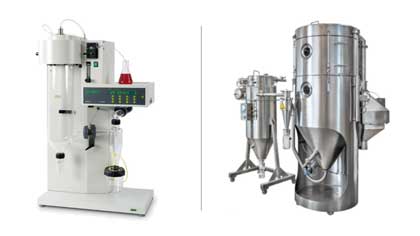16 Oct 2023
Are you still troubled by the characterization of solid state?
How to determine whether the prepared crystal form is the same?
Compounds have polymorphism. Is it necessary to conduct impurity crystal form research for raw materials and formulations?
How to distinguish between surface water and crystalline water?
What guidance can be obtained from DVS data?
For particle size distribution testing, how to choose between dry methods and wet methods, and how to interpret the test data?
With these questions, let's explore how to use characterization methods to reveal the nature of drug crystal forms.
The Significance of Solid State Research in Pharmaceuticals
Pharmaceutical molecules typically have different solid forms, with long-range disorderly arrangement forming amorphous structures, and long-range ordered molecule stacking forming crystals. Crystals can be single-component crystals or salts containing multiple components (including hydrates, solvates, etc.). The different crystal structures of pharmaceutical molecules are ultimately reflected in the physical properties of the crystals, which have significant differences in stability, bioavailability, scale-up production, and storage, thus affecting the efficacy and developmental viability of drugs.
Solid state research in pharmaceuticals aims to use comprehensive experimental schemes and advanced characterization methods to select the most advantageous solid forms (including salt forms, crystal forms, co-crystals) in terms of overall advantages (including stability, bioavailability, process viability, etc.). The characterization methods involved are the "true eyes" that help understand the nature and elucidate the causes of crystal forms. Therefore, comprehensive characterization not only facilitates the analysis of drug solid forms but also distinguishes the physicochemical property differences between different crystal forms, thereby solidifying the foundation for subsequent drug development, accelerating the drug development process, and providing strong support for patent protection.
Representative Characterization Methods
X-Ray Powder Diffraction (XRPD)
X-Ray Powder Diffraction is the main method for studying drug crystal forms and can be divided into powder diffraction and single crystal diffraction. Powder X-Ray Diffraction is a commonly used method to study and differentiate different crystal forms. It can be used not only for identifying the categories of crystal forms but also for controlling and quantitatively studying crystal forms after establishing a quantitative relationship between characteristic diffraction peaks and different crystal form contents. Single crystal X-Ray Diffraction provides direct evidence for crystal structure and has become the "gold standard" for structural confirmation.
Thermal Analysis
Thermal analysis mainly includes differential scanning calorimetry (DSC), differential thermal analysis, and thermogravimetric analysis. Among them, thermogravimetric analysis (TGA) and differential scanning calorimetry (DSC) are the main analytical methods. TGA is suitable for identifying the process of solvent removal, sublimation, and decomposition in crystals. Combined with other characterization methods, it can infer the presence of crystalline water or solvent in the crystal, thus quickly distinguishing between anhydrous forms, hydrates, and solvates. DSC is mainly used to analyze the melting and decomposition of samples and the presence of polymorphic or mixed crystal phenomena.
Dynamic Vapor Sorption (DVS)
Dynamic vapor sorption (DVS) is used to study the equilibrium, adsorption-desorption, diffusion coefficient, and permeability coefficient of water in samples. DVS characterization is mainly used to analyze the hygroscopicity of drugs, characterize the formation of hydrates, and study vapor-induced phase transitions, etc.
Polarized Light Microscope (PLM)
The polarized light microscope (PLM) can directly obtain information about the particle size, morphology, crystal growth, melting, intercalation, etc., of the samples. The use of a hot stage microscope can directly observe the thermodynamic dynamic processes such as phase transitions, melting, decomposition, recrystallization, etc., of crystals by heating or cooling a small amount of sample.
Particle Size Distribution (PSD)
Particle size distribution (PSD) affects many properties of drugs, such as dissolution rate, flowability, bulk density, etc., so the control and testing of particle size distribution are crucial for solid-state drug development and quality control. One of the commonly used testing methods is laser diffraction particle size analysis, which can be divided into dry methods and wet methods. Dry methods directly test solid samples by dispers

Testing Services
CrystalYun Solid-State Testing Center offers a range of characterization and testing services for both active pharmaceutical ingredients (APIs) and formulations. We have access to advanced analytical instruments and resources, including X-ray powder diffractometers, thermogravimetric analyzers, differential scanning calorimeters, dynamic vapor sorption analyzers, polarized light microscopes, laser particle size analyzers, and more.Our dedicated team of experts is here to assist and provide technical support, addressing any questions or concerns you may have. Our mission is to deliver efficient and high-quality characterization and testing services to meet your specific needs throughout the research and development process.Feel free to reach out to us to discuss your testing requirements and how we can assist you in achieving your goals.
Service Advantages
Small Quantities: Characterization with milligram-level samples to meet various stage requirements.
Leading Technology: Access to globally leading instruments and equipment, catering to diverse testing needs.
Efficiency: Rapid response and communication of characterization results within as quickly as one business day after receiving the samples.
Expertise: Comprehensive testing services to ensure the systematic and complete nature of solid-state data.
Comprehensive: Provision of accurate data analysis and professional research and development recommendations.


